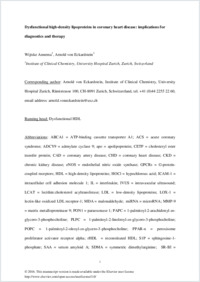Dysfunctional high-density lipoproteins in coronary heart disease: implications for diagnostics and therapy.
- Annema W Institute of Clinical Chemistry, University Hospital Zurich, Zurich, Switzerland.
- von Eckardstein A Institute of Clinical Chemistry, University Hospital Zurich, Zurich, Switzerland. Electronic address: arnold.voneckardstein@usz.ch.
- 2016-03-15
Published in:
- Translational research : the journal of laboratory and clinical medicine. - 2016
English
Low plasma levels of high-density lipoprotein (HDL) cholesterol are associated with increased risks of coronary heart disease. HDL mediates cholesterol efflux from macrophages for reverse transport to the liver and elicits many anti-inflammatory and anti-oxidative activities which are potentially anti-atherogenic. Nevertheless, HDL has not been successfully targeted by drugs for prevention or treatment of cardiovascular diseases. One potential reason is the targeting of HDL cholesterol which does not capture the structural and functional complexity of HDL particles. Hundreds of lipid species and dozens of proteins as well as several microRNAs have been identified in HDL. This physiological heterogeneity is further increased in pathologic conditions due to additional quantitative and qualitative molecular changes of HDL components which have been associated with both loss of physiological function and gain of pathologic dysfunction. This structural and functional complexity of HDL has prevented clear assignments of molecules to the functions of normal HDL and dysfunctions of pathologic HDL. Systematic analyses of structure-function relationships of HDL-associated molecules and their modifications are needed to test the different components and functions of HDL for their relative contribution in the pathogenesis of atherosclerosis. The derived biomarkers and targets may eventually help to exploit HDL for treatment and diagnostics of cardiovascular diseases.
- Language
-
- English
- Open access status
- bronze
- Identifiers
-
- DOI 10.1016/j.trsl.2016.02.008
- PMID 26972566
- Persistent URL
- https://folia.unifr.ch/global/documents/142204
Statistics
Document views: 3
File downloads:
- fulltext.pdf: 0
